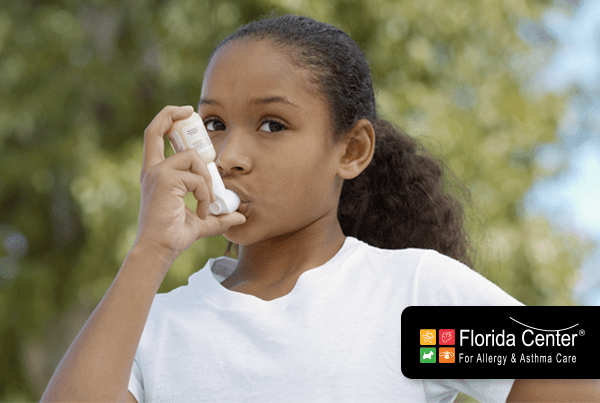In celebration of Asthma Awareness Month we have answered your most FAQs .
Do allergies cause asthma?
Allergies don’t cause asthma, but the two are related.
Children with allergies may develop asthma.
Not everyone with allergies develops asthma.
Children whose families have history with allergies and asthma are likely to suffer from allergies and/or asthma.
In other words, the variables are numerous and nothing is set in stone.
Asthma vs. COPD (Chronic Obstructive Pulmonary Disease) .
There are common symptoms like coughing and shortness of breath, when wheezing and tightness of chest are acute it’s asthma. Asthmatic patients are more likely to present in conjunction allergic rhinitis or eczema (atopic dermatitis). Smoking is a trigger for COPD, asthma can affect smokers and non-smokers. Patients with COPD can also have asthma (see n. 3) . How to recognize and treat? Visit an allergist.
Asthma and smoking.
Roughly 25% of asthma sufferers are cigarette smokers or former. Symptoms are worst, poorer control, higher number of unscheduled healthcare visits, including ER. If there was the need of another reason to stop smoking or never start.
Childhood asthma and treatments.
Children develop asthma before turning 5.
Common symptoms are coughing (it may worsen at night), wheezing, uncomfortably tight chest, frequent bronchitis, a cold that lasts more than usual.
Asthma triggers: colds, allergens like pollen, dust mites, or pet dander, exercise, smoke and second-hand smoke.
How to recognize the symptoms of an asthma attack: trouble with breathing, stomach sucked-in under the ribs in attempt to inhale, trouble with speaking.
Diagnosis: it can be tricky for similarity of symptoms with common colds. If symptoms are constant and severe, consult an asthma specialist, use medications with precision and diligence, compile an Asthma Action Plan to track results. (see below).
What’s an Asthma Action Plan?
It’s a written tool redacted by the specialist that outlines and tracks the progress of a child’s asthma with symptoms, list of medications, progress. It is a document that will help keep asthma flare-ups under control. It is usually made to be shared with school teachers, care takers, sport coaches.
Spirometry
Sprirometry is also called pulmonary function test, is a breathing test that helps calculate the amount of air that flows in and out of your lungs when breathing.
It helps diagnosing asthma.
Avoiding the test poses the risk of taking the wrong medications that do not treat your condition.
Many conditions have the same symptoms as asthma and the first step to take when you have asthma-like symptoms is the right diagnosis.
How to prevent asthma?
The best way to prevent an asthma attack is to avoid the trigger. In other words, after detecting what is the culprit of your condition, the number one preventative measure to be adopted after 1. taking medications as prescribed and 2. following the asthma action plan, is 3. to limit and ideally reduce to zero any contact with the triggers. Let’s say for example pollen is your pesky enemy, your best choices will be
- to use air conditioning in the house and the car and keep windows closed.
- avoid running outdoors when pollen levels are at the highest
- when coming back home, remove clothing and keep far away from bed
- wash your hair before going to bed
If pet dander is the trigger of your asthma, allergy shots (immunotherapy) is the answer besides banning the pet from your bedroom.
Mold and dust mites are recurring in South Florida.
Keeping mold at bay in the house equals with
- cleaning kitchens, bathrooms and basements often
- Maintaining humidity below 50%
As for dust mites the most common suggestions are:
- Hypo-allergenic pillow cases and mattress covers;
- Wash bed linens weekly at temperatures no lower than 130 F
- Avoid decorations like stuffed animals or plastic and dried flowers
- Vacuum carpets and draperies
Can I be treated for asthma, while I am being treated for allergies? Are medications and treatments separate?
Allergy-induced asthma is when the same substances that trigger your allergies cause also asthma symptoms.
Pet dander, dust mites and pollen are the most common causes of allergy symptoms whereas food allergies and eczema may also cause asthma symptoms. When your body reacts to an otherwise armless protein, it shows it with symptoms like runny nose, nasal congestion or eyes irritated in some people and shortness of breath or lung and airways construction in others.
There are a few medications that treat both allergies and asthma, but they may be prescribed together with other medications specific only to allergies or asthma. However the most important step to prevention and treatment is diagnosing, recognizing and avoiding the allergens.
To know more about inhalers, visit the Glossary in our website.
Are there any medicines that can make asthma worst?
- Aspirin or any anti-inflammatory medication like containing ibuprofen or naproxen can be harmful for asthmatics.
- Acetaminophen to reduce pain and fever may be the solution, although it has been linked lately to worsening asthma symptoms.
- Antihistamines are generally harmless although may produce side effects.
- Medications to control blood pressure are generally known to make asthma worse.
- The contrast dye for X-rays is incompatible with asthma medications and it’s mandatory to inform the technician that you have asthma. An allergic reaction to a medication can cause dizziness or wheezing, and it’s always recommended to consult a physician.
Asthma and home.
When you, or your child, have been diagnosed with asthma, a lot of thoughts and actions go into adapting the environment. Some preventative measures are:
- improve indoor air by eliminating stuffed animals,
- avoid scented oils or candles,
- eliminate smoke or wood fires,
- keep mold and dust-mites at bay by frequently cleaning out air conditioning ducts
- keep windows closed when pollen is at highest levels, normally early in the morning
- eliminate down feathers bedding
- vacuum frequently
- substitute carpet and upholstery when possible
- use de-humidifiers and not humidifiers
- avoid house-plants or real Christmas tree
- avoid mold in the bathroom, especially ventilating and eliminating moldy shower curtains
Asthma and the outdoors.
If you or your child has asthma, it doesn’t mean you should avoid the outdoors, but there are outside conditions that are detriment and may worsen symptoms and quality of breathing. Smog, pollution, low-level ozone, car exhaust, and what’s commonly called particle pollution (mini-particles of smoke, dust and soot suspended in the air we breathe).
—
Resources
- www.kidshealth.org
- www.aaaai.org
- www.Mayoclinic.com
- www.familydoctor.org
- www.fda.gov
- www.chosingwisely.org





